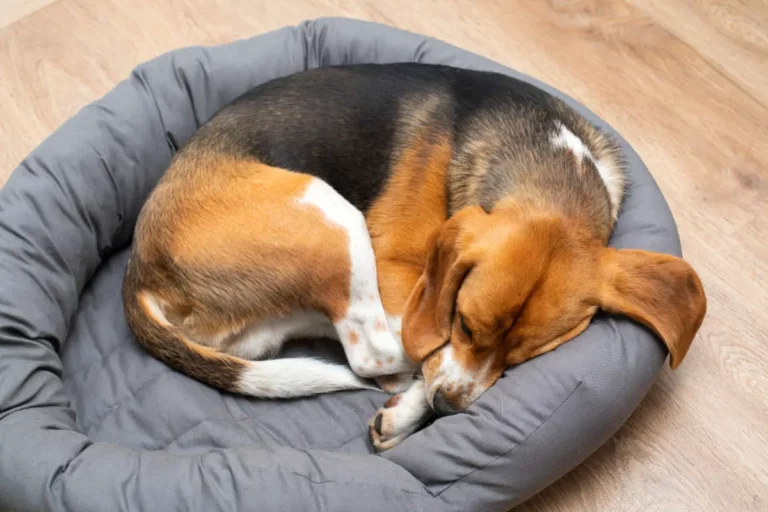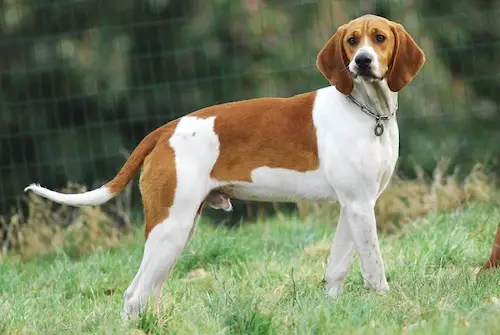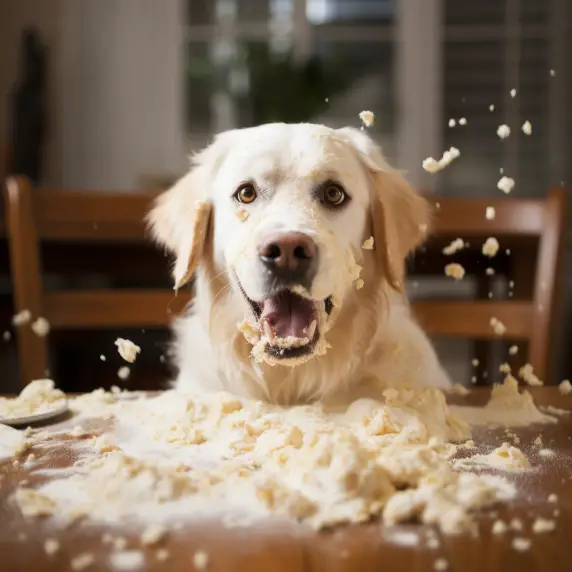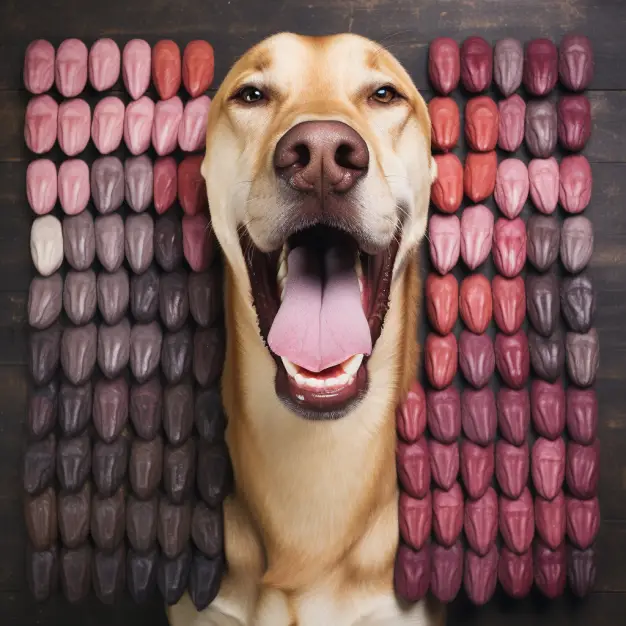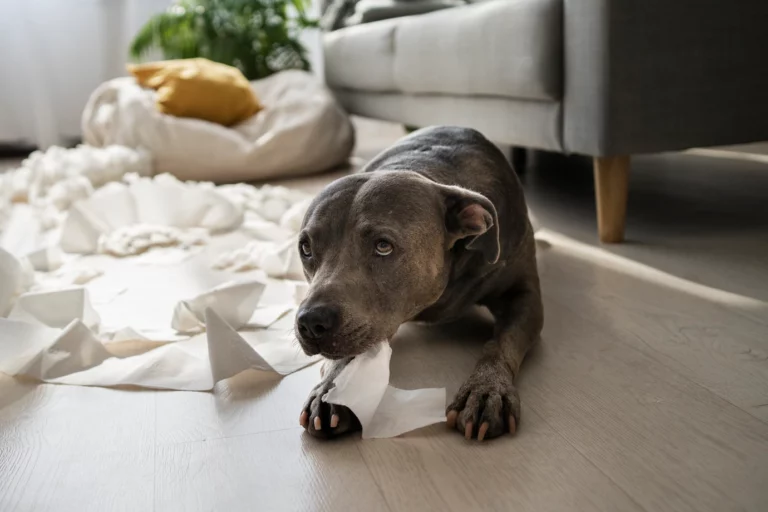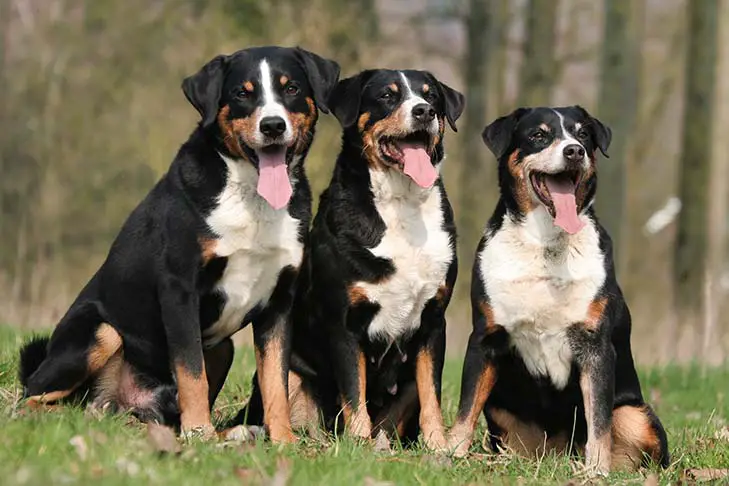Dog Scooting After Grooming (5 Reasons & Home Remedies)
Many dog owners who have recently groomed their dogs report strange behavior mostly within the few hours or days that follow.
Often, it’s their dogs continuously rubbing or dragging their bum, or any other areas of their body that were groomed across rough surfaces such as rugs, furniture, and various objects. This is an uncanny manifestation known as scooting.
If your pooch presents with scooting after grooming, it indicates that his bum is itchy, irritated, or in pain. These conditions are usually caused by the heavy application of sharp grooming tools, anal impaction, or infection. More serious cases like allergies are relatively rare. Regardless of the cause, immediate veterinary intervention is very important.
During grooming, the veterinarian cleans the anal glands. Besides that, the dog’s hair needs to be clipped or thinned slightly closer to the skin to accomplish a more natural haircut throughout the rest of the dog’s coat.
To trim it off, groomers often use a clipper or scissors. All of these may cause some irritation or itchiness to your dog’s skin.
Dog owners, especially when new to the world of canines, can get confused in situations like these about what it indicates, and whether or not they should take any action.
Key takeaways
Dog scooting after grooming could be due to irritation, discomfort, or a reaction to grooming procedures.
The groomer may have accidentally nicked the skin or irritated the anal glands, causing discomfort.
Some dogs may experience stress or anxiety from grooming, resulting in unusual behaviors like scooting.
If the scooting persists, it’s important to consult a veterinarian as it could indicate a more serious issue such as impacted or infected anal glands.
Regular grooming and anal gland check-ups can help prevent discomfort and health issues that lead to scooting.
What is Scooting in Dogs?
Scooting in dogs refers to the act of a dog dragging its rear end or bottom along the ground, typically in a seated position. This behavior may appear amusing, but it can indicate that the dog is experiencing discomfort or irritation in the anal area. Some common reasons for scooting in dogs include:
- Anal sac issues: Dogs have two small glands, called anal sacs or anal glands, on either side of their anus. These sacs produce a smelly secretion that dogs use for marking territory and communication. Sometimes, the sacs can become impacted, infected, or abscessed, leading to discomfort and prompting the dog to scoot.
- Intestinal parasites: Worms, such as tapeworms, can cause itching and irritation around the anus. A dog may scoot to try to alleviate the itchiness.
- Allergies: Dogs can develop allergies to environmental factors or certain foods. These allergies can result in skin irritation or itchiness around the anus, causing the dog to scoot.
- Perianal irritation: Inflammation, injury, or infection of the skin around the anus can cause discomfort, leading to scooting.
- Perianal tumors: In rare cases, growths or tumors in the perianal area can cause discomfort and lead to scooting.
If your dog is frequently scooting, it’s essential to consult with a veterinarian to determine the cause and appropriate treatment.
Before you do, let’s dive into some of these in more detail…
Why Is My Dog Scooting on the Floor After Grooming?
If you find your newly groomed dog scooting, do not assume that this behavior is normal. It is possibly a case of clipper burn which often resolves spontaneously or anal gland issues which is persistent and can progress to become life-threatening when left untreated. These conditions bring about discomfort to your pooch making them scoot on rough surfaces.
We would like to expatiate on the common reasons why dogs scoot after grooming.
1. Perianal Irritation
Clipping dogs too often or close to the skin, using a dull blade, or applying too much pressure while clipping is likely to cause irritation or itchiness around the anal area.
Since dogs cannot scratch itchy areas the way humans do, they utilize scooting to get immediate relief. This is more common when your dog is very sensitive.
The process of scooting (especially on textured surfaces) coupled with other common responses like licking, biting, and humping can lead to injury, inflammation, and possibly infection of the affected area.
Also, sometimes pre-existing skin conditions such as allergies can become triggered by ingredients in dog shampoos and sprays, thus leading to rashes, itching, lesions, and swelling.
Allergies are a major cause for concern in dogs and if you are not sure about why your dog is scooting, it’s important to consult your health vet for a thorough examination, proper diagnosis, and an effective treatment plan.
2. Clogged Anal Sacs
A dog has two sacs under the tail on either side of the anus. They are also called anal glands. They produce a smelly liquid that dogs use to identify each other and mark their territory.
Clogged anal sacs can be a precursor to dog scooting.
Normally, when dogs poop, a small amount of this substance escapes through a duct and is expelled alongside feces. However, when bowel movement is slowed down, the fluid in the anal glands is no longer released.
Hence this fluid accumulates in the gland and begins to solidify, blocking the duct through which they are expelled. This is known as anal gland impaction and it often causes discomfort in your pooch. Exactly, why your pooch finds relief in the act of scooting.
These glands then require a manual pressing to open them, which a groomer or a vet can do during the grooming session. However, this may come at a cost, as your furry friend might have an irritable bum. It may be temporary, but the dog will do scooting after grooming to comfort himself.
To avoid the problem of clogged glands, keep an eye on the dog’s diet. Make sure he is getting enough fiber in his diet. It will keep the stools solid or in a semi-solid state and the glands will also remain open. If the dog’s stool changes its form, consult the vet and get advice.
No products found.
3. Infection of the Anal Sacs
When the anal glands of your dog become clogged, it’s always advised that you express them to prevent infection or the formation of an abscess. Though, it’s quite rare.
The act of grooming doesn’t necessarily cause infection but can intensify the itchiness. Well, it’s a big plus because now you know that your dog’s licking and scooting is a sign that something has gone wrong down there.
It’s important that you take immediate action by seeking help from your vet. After all, the causes of scooting may range from mildly concerning to life-threatening infection, of which an abscess could be if left untreated.
Taking your pet to the vet will ensure that the abscess is incised and drained without further complications but if the abscess is allowed to rupture there’s often a discharge of bloody foul-smelling pus which can be a source of bacterial infection to other parts of the body.
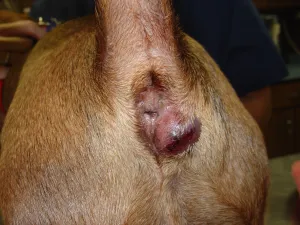
4. Expression of Anal Glands
Many groomers perform anal gland expression routinely and include it as part of their normal grooming services. However, it’s best to visit the vet rather than a groomer if you want the procedure to go on smoothly without leading to any further complications.
Besides, the appropriate interval for the expression of glands might vary from one dog to another regardless of the breed.
Also, there are two methods used in expressing anal glands, external and internal methods. Groomers often use the external method for this purpose. On the other hand, vets use an internal procedure, which is preferable and safer.
I’ll go further to explain in detail how these two methods of gland expression are performed.
No products found.
External expression:
The idea of anal glands expression is to empty them of any fluid accumulated there. In an external expression of glands, the groomer puts his finger on one gland, thumb on the other, and squeezes them together. It should drain them entirely, but it is often not the case, and some fluid remains inside.
The fluid that is not expelled during the external gland expression can be infected. In this case, the glands become inflamed clogging the already narrow opening that empties the gland. This results in discomfort and your pup may resort to scooting during this time to
Internal expression:
In an internal expression, the vet inserts his index finger inside the dog’s bum and squeezes the gland one at a time by pressing it against his thumb outside. It empties them thoroughly, and the animal gets relieved of any pain or discomfort. There are usually fewer side effects to this method.
5. Pain
Pain receptors are widely distributed through the dog’s body and often trigger a response when stimulated. Pain in the perianal area can make dogs respond by scooting, yelping, licking, or trying to avoid being touched in the affected area. Pain in your dog’s bum is also likely to intensify when he tries to poop.
Unfortunately, grooming is one of the activities that can expose your dog to that sort of risk. A variety of painful injuries can stem from grooming activities. They include clipper burns, fur matting, nicks and scrapes, allergic reactions, and rupture or expression of the anal sacs.
Pain can be caused by numerous underlying conditions and veterinary intervention is very much needed if you suspect that your pooch may be in pain.
What is my dog thinking?
Your dog might be feeling some discomfort or itchiness, perhaps due to a grooming procedure or product, and scooting is their way to try and alleviate it.
Dog Scooting Treatment
Effective Home Remedies for Dog Scooting
We will now discuss some simple home remedies to relieve dogs from post-grooming scooting. These include the following;
When your dog starts scooting, it’s understandable to want to provide immediate relief. Here are several home remedies you can try to address dog scooting:
1. Maintaining proper hygiene
Regular grooming and bathing: Keeping your dog clean and well-groomed can help prevent scooting caused by debris, dirt, or allergens that may irritate the perianal area. Regularly trim the hair around your dog’s bottom to reduce the chance of matting or build-up of faecal matter. Bathe your dog with gentle, hypoallergenic pet shampoos to avoid additional irritation.
Checking for and removing debris near the anus: Inspect your dog’s anus regularly for any debris, such as small sticks or grass seeds, that could cause discomfort. If you find anything, gently remove it with a clean, damp cloth, and monitor your dog for continued scooting or signs of infection.
2. Dietary adjustments
High-fiber diet: A diet rich in fiber can help regulate bowel movements and reduce the risk of constipation or impacted anal glands. Incorporate fiber-rich foods like pumpkin, sweet potatoes, or green beans into your dog’s diet, or choose a high-quality dog food with added fiber.
Probiotics: A healthy gut can contribute to a healthy dog, and this includes reducing scooting. Probiotics help maintain a healthy balance of gut bacteria, potentially easing digestive issues that might lead to scooting.
Identifying and eliminating food allergens: Food allergies can cause itching and inflammation around the anus. If you suspect your dog has a food allergy, consult your veterinarian about conducting an elimination diet to pinpoint the allergen. Then, choose a dog food that does not contain the problematic ingredient.
3. Natural supplements and remedies
Pumpkin: Pumpkin is a natural source of fiber and can help support your dog’s digestive health. Add plain, canned pumpkin (not pumpkin pie filling) to your dog’s diet to increase their fiber intake and promote regular bowel movements.
Apple cider vinegar: Dilute apple cider vinegar with water and apply it to the affected area using a clean cloth. This can help relieve inflammation and kill bacteria that may contribute to scooting. However, avoid using apple cider vinegar on open wounds or broken skin.
Omega-3 fatty acids: Supplements containing omega-3 fatty acids, such as fish oil, can help reduce inflammation and support your dog’s skin health. Consult your veterinarian for the appropriate dosage and frequency for your dog.
4. Herbal Remedies
Some pet owners have found success using herbal remedies to alleviate discomfort associated with scooting. Certain herbs, such as calendula or chamomile, can soothe inflamed skin when applied as a topical solution. However, it’s essential to consult your vet before introducing any new substances to your dog’s regimen, as not all herbs are safe for pets.
5. Natural Anti-Parasitic Treatments
If parasites are causing your dog’s scooting, certain natural remedies might help. Foods like carrot and watercress have been touted for their anti-parasitic properties. Similarly, some believe apple cider vinegar can help deter parasites when added to your dog’s water. However, these remedies should not replace a vet-prescribed anti-parasitic treatment.
Remember, these home remedies can provide temporary relief, but they’re not a substitute for veterinary care. If your dog continues to scoot after trying these remedies, it’s time to visit the vet. After all, understanding the underlying cause of scooting is crucial to effectively treating and preventing this behavior.
Here are some effective digestive supplements you may want to try:
Tips to Prevent Dog Scooting
Preventing an issue is often easier than resolving it. Here are a few strategies to help keep your dog’s rear end scoot-free:
1. Regular Vet Check-ups
Frequent visits to the vet can help identify any potential issues before they become serious. Most vets will check your dog’s anal glands during routine exams, which can help catch any problems early.
2. Maintain a Balanced Diet
A balanced diet is key to your dog’s overall health and can help prevent scooting. Ensure your dog’s diet is rich in fiber, which can assist in proper digestion and prevent anal gland issues. It’s also vital to keep your dog hydrated, as this aids in digestion as well.
3. Proper Grooming
Regular grooming can prevent potential skin irritations that might cause scooting. Keep the hair around your dog’s rear end clean and neatly trimmed. Remember, some breeds may require more grooming than others.
4. Regular Deworming
Parasites are a common cause of scooting. Regular deworming, as prescribed by your vet, can help keep these unwelcome guests at bay.
5. Pay Attention to Allergies
Allergies can lead to itching and irritation, causing your dog to scoot. If you notice your dog scooting during certain seasons or after eating certain foods, they may have an allergy. Work with your vet to identify and manage potential allergens.
How to Identify Scooting Behavior in Dogs
Recognizing the signs of dog scooting is the first step towards addressing this issue. While scooting can look funny or even cute, it’s a clear sign your dog is trying to relieve some discomfort. Here’s what to watch for:
1. The Scoot Itself
The most obvious sign of scooting is the scoot itself. You’ll typically notice your dog dragging their rear end along the ground, often while sitting down. It’s a peculiar sight, and one that most dog owners can easily identify.
2. Frequent Licking or Biting at the Rear
If your dog is frequently licking or biting at their rear, it may be a sign that something is bothering them in that area. This could be anything from irritation to an infection.
3. Changes in Bowel Movements
Changes in your dog’s bowel movements can also be a sign of a problem. If you notice constipation, diarrhea, or any other significant changes in your dog’s stool, it may be related to the cause of the scooting.
4. Unpleasant Odors
If you detect an unusual or unpleasant smell coming from your dog’s rear, it could be a sign of an anal gland issue, which can lead to scooting. This is often accompanied by other signs such as redness or swelling in the area.
Frequently Asked Questions
Can over-the-counter medications help with scooting?
While over-the-counter medications may provide temporary relief for certain symptoms related to scooting, such as itchiness, it’s important to address the underlying cause of the scooting. Consult your veterinarian before administering any medication to your dog, as some human medications can be harmful or toxic to pets.
How long does it take for home remedies to work?
The effectiveness and duration of home remedies can vary depending on the cause of the scooting and the specific remedy being used. Some remedies may provide immediate relief, while others may take days or weeks to show results. If your dog’s scooting does not improve or worsens after implementing home remedies, consult your veterinarian for further guidance.
Is there a specific diet or brand of dog food that is best for preventing scooting?
There is no one-size-fits-all answer to this question, as the best diet for preventing scooting will depend on the individual dog and the cause of their scooting. A high-fiber diet, a hypoallergenic diet, or a diet free from specific allergens might help prevent scooting in some dogs. Consult your veterinarian for personalized advice on the best diet for your dog based on their age, breed, weight, and any underlying health conditions.
Are there any risks associated with expressing a dog’s anal glands at home?
There are potential risks involved with expressing your dog’s anal glands at home. If done improperly, you may cause injury, infection, or further impaction. It’s important to learn the correct technique from a veterinarian or professional groomer before attempting to express your dog’s anal glands. If you are unsure or uncomfortable with the process, seek professional help to ensure your dog’s safety and comfort.
Why is my dog licking his bum excessively after getting groomed?
Your dog may lick his bum after grooming because he feels itchiness and irritation down there. Licking is just a way to give relief to himself. Check whether the area is inflamed or swollen This can be due to clipper burn, clogged anal glands, or other grooming injuries.
How do you relieve itching in dogs after grooming?
There are several remedies you can try to relieve itching in dogs irrespective of whether it is associated with grooming but it’s important to first talk with your vet concerning this issue. You can give him an oatmeal bath, an anti-inflammatory treatment, or a warm compress around the affected region.
Increasing your dog’s fiber intake, ensuring he’s always hydrated, and feeding him a balanced diet are also great ways to improve bowel movement, thereby, preventing anal impaction.
Why do dogs act weird after getting groomed?
As we all know, grooming exposes your dog to certain conditions that can cause itchiness and irritation. Dogs often display some weird behaviors like snapping, yelping, licking, or scooting as a response to feeling discomfort they are experiencing after grooming. It’s basically the dog’s way of saying “there is got to be something wrong down there”
Why is my dog’s bum sore after grooming?
It is most likely to be a clipper burn or the heavy application of the scissor. When dogs scoot on roof surfaces after grooming their bum often becomes sore. Consult a vet if the sore does not mitigate in 2-3 days.
How long does clipper burn last?
It depends on how deep the cut has been. If it is a minor scratch, it will fade in 1-2 days. The recovery phase may stretch for seven days or more for deeper cuts.
Why is my dog still scooting after glands are expressed?
Scooting can be a side effect of getting the glands expressed especially when done routinely. In the case of external expression which is more common with groomers, you are more than likely to experience such a condition where your dog may be feeling irritation around the anus, which, in turn, forces the dog to go scooting.
Final Thoughts
In summary, dog scooting after grooming can be an unsettling sight for pet owners, but it’s important to understand that it is not uncommon. Grooming may cause temporary irritation, inflammation, or discomfort that leads to scooting behavior.
To minimize the likelihood of scooting after grooming, make sure your groomer is experienced and gentle in handling your dog, particularly in sensitive areas like the anus and anal glands.
If your dog’s scooting persists or worsens after grooming, or if you notice any signs of infection or injury, it’s essential to consult your veterinarian for a proper evaluation and treatment.
Regular grooming is an essential part of maintaining your dog’s overall health and well-being, so ensure that you find a groomer who is attentive to your pet’s individual needs and is committed to making the experience as comfortable as possible for your furry friend.


